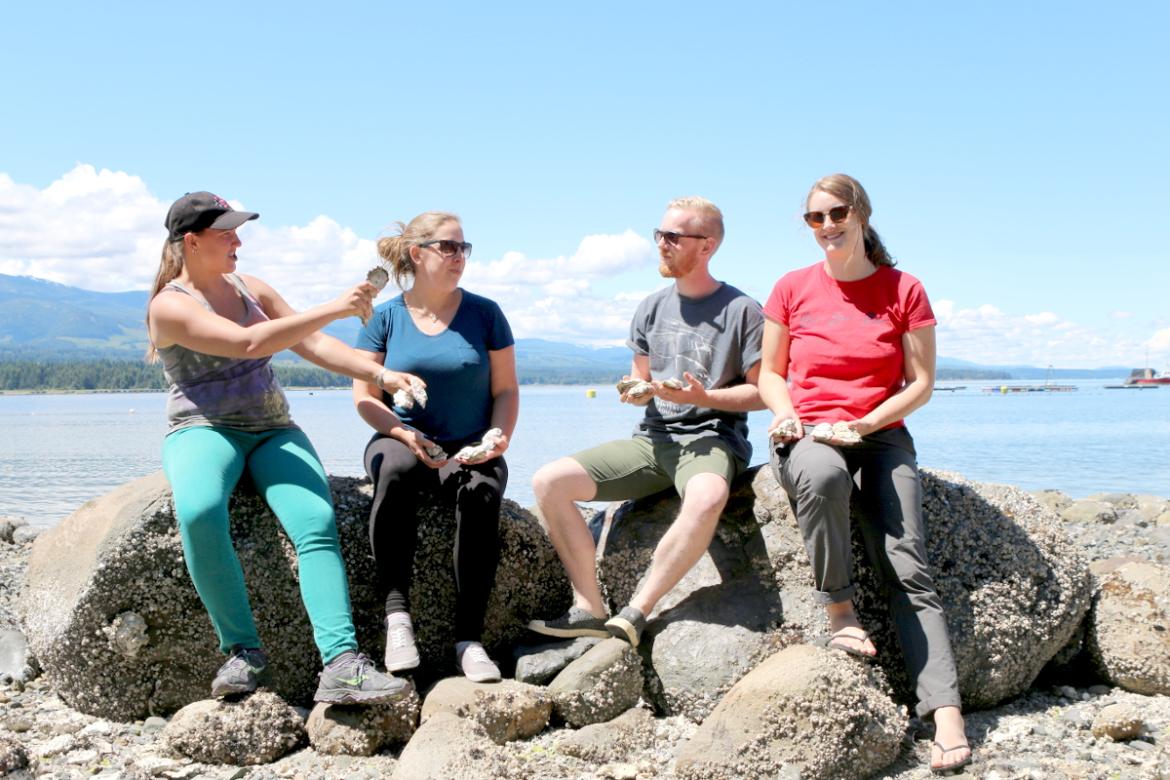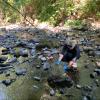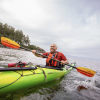
After tagging hundreds of shellfish at VIU’s Deep Bay Marine Field Station, VIU student Raquel Greiter (left) was ready to fling an oyster shell at project leader Garth Covernton. VIU student researchers Maggie Dietterle (right) and Caitlin Smith (middle) are also lending a hand on the project.
July 15, 2016 - 1:15pm
VIU’s Deep Bay Marine Field Station is ground zero for a research project designed to monitor shellfish for microplastic contamination
With the help of five Vancouver Island University (VIU) student researchers, Garth Covernton, a University of Victoria (UVic) master’s student, and his team waded into the ocean at three different spots along Vancouver Island’s coastline to collect more than 2,000 oysters and 1,000 clams for tagging. The group is using the shellfish to monitor for microplastics, which have become a global problem.
“Microplastics are too small to see with the eye and because of that they can easily enter a wide range of organisms. Waste water treatment plants don’t pick them up and they cannot be easily digested or broken down by bacteria which is why they persist in the environment,” said Covernton. “Scientists are currently trying to assess what that means and I’m hoping my study will make a small contribution to that discussion.”
Thanks to a partnership between VIU and UVic, Covernton is working out of VIU’s Deep Bay Marine Field Station to conduct his research, under the supervision of thesis advisor Dr. Sarah Dudas, who is a Canada Research Chair and biology professor at VIU.
Microplastics are generally described as smaller than five millimeters and can include everything from plastic microbeads that are used in rinse-off cosmetics and toothpaste products to the thousands of plastic fibres that come off our fleece clothing every time they go through the wash. Secondary sources of microplastics are simply larger pieces of debris that have been broken up and worn down by the waves, wind and sun. A study recently published in Science Magazine estimated that in 2010 between 4.8 and 12.7 million metric tons of plastic was entering the ocean annually.
“The ability of microplastics to absorb and concentrate chemicals that may be eaten by organisms makes them a serious emerging threat to wildlife and natural ecosystems and potentially, human health,” said Dudas. “We are looking at shellfish because they are filter feeding organisms. They accumulate anything that is in the water and they live on the coast where the most drastic changes are happening, which makes them excellent sentinels of ecosystem health.”
Covernton’s study is being funded by the Department of Fisheries and Oceans and the BC Shellfish Grower’s Association, which represents a shellfish farming community that provides over 1,000 full-time jobs in rural and coastal BC communities and accounts for over $33 million in shellfish farm sales annually. Association president Steve Pocock says they were excited to work with VIU on the study because anything that affects the oceans is a concern to them as a community.
“Our lives are spent on the ocean so anything that could potentially impact the health of the coastal ecosystem is of interest to us,” said Pocock. “As an industry we are keen to find out what we can do to mitigate the amounts of plastic making its way into our oceans. Knowledge of the problem is the key to being effective at that.”
Maggie Dietterle is one of five VIU biology students assisting with Covernton’s research. Their tasks included using felt pens to handwrite identification numbers on every oyster and clam and measuring the shells so that when they are collected again in the fall, Covernton will know how much they grew.
“Microplastics are an added factor to plastic pollution. The beading in toothpaste, confetti from parades, the glitter people put on their faces, the sources are endless and the hardest part is educating people about it,” said Dietterle. “Since I started the project I’ve been going home and talking to my friends and family about this. I want to get the word out and start them thinking about where the plastic products they buy end up. Shellfish are resilient so I ask myself, if they are being affected by microplastics then what are the microplastics doing to the more vulnerable organisms in the oceans?”
The more than 3,000 shellfish tagged by the students have been released at 22 beaches, 11 shellfish farms and 11 wild sites, located in four Vancouver Island coastal regions. Covernton will be looking to re-harvest them in September to determine how much microplastics they consumed over the summer.
-30-
MEDIA CONTACT:
Dane Gibson, Communications Officer, Vancouver Island University
P: 250.740.6288 | E: Communications@viu.ca T: #viunews
Tags: Research






